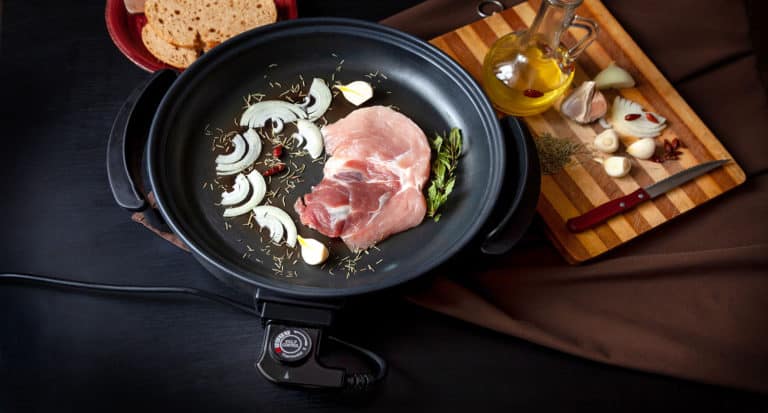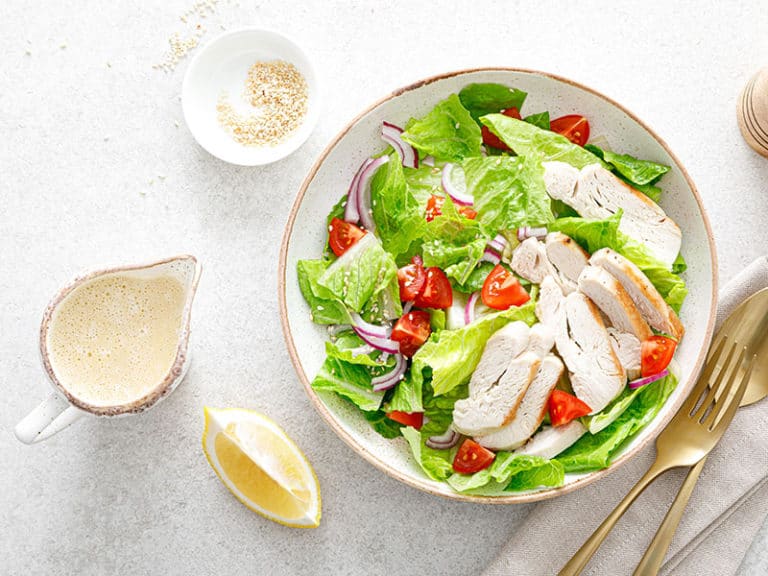Top 12 Best Santoku Knives
When you buy through our links, The Breslin may earn an affiliate commission. Learn more
The kitchen will become softer than ever when you own a versatile knife to help prepare the dishes more beautiful and delicious. At the same time, perform basic operations in the kitchen process such as cutting, cutting, and slicing.
Although there are more and more handy tools to do this, a sharp kitchen knife is still the most favorite housewife. Keep track of the article below I can help you pick out the most magical santoku knives!
What is a Santoku knife?
With its strange Japanese name, the Santoku knife (sahn-toh-koo) can be used for some sophisticated tasks, like that of a professional chef. So, what is Santoku? What distinguishes them from other functional knives?
1. A Brief Definition of a Santoku Knife
Santoku is simply a sliced knife used for slicing and slicing, the function used like traditional European chef knives (Western).
2. Outstanding Features of a Santoku Knife
Santoku knives are lighter, thinner, shorter and stiffer than traditional Western chef knives. It also achieves excellent balance. The absence of swabs supported at the end of the blade allows the full length of the blade to be used.
The tip of the blade along the ridge of the knife bends softly downwards, but the cutting edge itself is completely flat. This helps it to be popular with tourists because, of course, it is not sharp and not dangerous to carry.
And often, some santoku knives will be designed with additional indentations on one side (Hollo technology), so that the slices are better, without food sticking on the edge of the knife.
This Santoku knife is a professional and sophisticated tool. It was initially invented for Japanese homemakers. While most other Japanese knives have specific functions, Santoku has a broader and more universal purpose.
It almost has “three purposes” (San – meaning 3): Cutting meat, fish, and vegetables. Although it may look a bit like a Western chef’s knife, you can keep in mind that it was invented for Japanese homemakers who want to cook Western food.
Specifically, the knife was created for Japanese women and is designed to suit people with small hands. Similar to Western specialized knives but made in Japan, such as Kyoto.
A Santoku knife has a necessary length of about 7 inches (15-18cm). Most western knives often maintain an angular amplitude of 30 ° -45 °, while Japanese knives maintain an extremely high angle, only about 20 ° -25 °.
The blade, traditionally, has no curves. Japanese cooks tend to use forward or reverse cuts and use vertical force. That action, when used with Western chef knives, is tough to achieve as with Santoku.
Ironically, the Santoku knife craze in the US-led them to exist knives with curved blades, similar to Western Chef’s knives. The French-style knife has a straight blade curved upwards on the abdomen, while the German style is with a curved blade along its entire cutting edge.
And among them, it is noticed that teeth, Santoku knives often retain sharp edges longer than the above knife lines.
3. The Reason You Should Buy a Santoku Knife
The Santoku knife does not have a blade that supports the end of the blade like most other knives, but rather is a protective piece connected to the inner arched handle. When you hold the knife and put your finger in, it will help you not hurt your hand and control the blade better.
Some people prefer to use a knife without a gauze, for their own advantage, such as allowing you to use the end of the blade as a lever for faster shredding. Alternatively, you can grip the handle tightly and put forward force to let the weight of the edge to help you cut heavy objects.
Many cooks prefer to use Santoku for everyday tasks, as they say, that Santoku is more versatile than a chef’s knife. But in fact, professional chefs still prefer Western chef knives, and Santoku is suitable for family kitchens, especially for Asians, with the characteristic of having small hands.
General Keywords of the Best Santoku Knives
Are you a homemaker or a professional chef? What purposes will you use the best Santoku knife for? Determining your situation and your budget helps you save your time a lot. The reason that I want to give some general keywords is that you can read quickly and consider instantly about your target.
You can also click on the link immediately then take note of your favorite product at the detailed review part.
- Best Overall: Zelite Infinity Seven Inches Santoku Knife
“Create a sense of comfort and safety, steady and balanced movement.” - Best Budget: Cuisinart C77TR-7SAN Black Santoku Knife
” Easy control, price is a bargain, durable classic design.” - Best for Homemakers: Wusthof WU4182 4182 Santoku Knife
” Inspiring cooking, bringing a new breath to the family kitchen, the right size.” - Best for Chef: Oxford Chef Santoku Knife
” Professional, Japanese cuisine spirit, delicate appearance, and great power.” - Best for Kids: Farberware 5119324 Santoku Knife
” Bright colors, top brand reputation, and easy cleaning with dishwashers.” - Best Cooking Illustration: Dalstrong Santoku Knife
” Outstanding unique style, impressive angle, creating personality and flexibility in application.” - Best for Cutting: Sunnecko All-Purpose Cutting Santoku knife
” Adapt well to most user needs, versatile cutting, and ideal weight.” - Best for Slicing: Dalstrong Phantom Series 7 inches Santoku Knife
” The unification of the opposites, incredible performance, and recommended by top chefs.” - Best for Peeling: OXO 11162500 Mini Best Santoku Knife
” Featuring an Asian knife, compact for meticulous maneuvers and exceptionally versatile.” - Best Wood Handle: Kessaku Samurai series wood handle Santoku Knife
” Hand made, advanced techniques, high-quality materials, and good heat resistant wood handles.” - Best Compact: Tuo 5.5 inches Convenient Handy Santoku knife
” Varied choices, easy-to-carry containers, and promising new brands.” - Best Versatile: MOSFiATA Santoku knife
” Suitable for families and kitchens in restaurants, a full set of utensils and durability.”
Table of Basic Information for the Best Santoku Knives
Although a knife is just a small factor in the kitchen, choosing the best Santoku knife, which is proper and compact enough for your hand, is quite necessary.
Furthermore, the material makes much influence on the quality of a knife so that you should go through it to ensure your cooking progress will run well and your family’s health won’t be harmed.
The 12 Best Santoku Knives Reviews
Experts also evaluate the knives based on grip angle and pressure on the user’s wrist. The following are the top 12 best Santoku knives that have been tested with certainty and receive a lifetime warranty policy from genuine that will make you feel satisfied when performing the skills of cutting, slicing, and peeling.
Zelite Infinity seven inches Santoku knife
(Best Overall Option)

As someone who has a special love for cooking, I recommend a Santoku knife that can satisfy all your needs. The first knife in today’s list of valuable suggestions has been tested and evaluated by many reputable experts.
Stainless steel material ensures health safety, eye-catching design, but incredibly sharp, accurate on every knife. Every experience will be most valuable when you can try it for yourself; I think this product is worth giving it a chance to be in your kitchen.
Key features:
- Sharpness from 12-15 degrees
- Hardness HRC 61 + (-) 1
- Anti-rust and antibacterial
- G10 handle with strong rivets
- High-end packaging
Pros
- Value for money for efficiency
- Beautiful pattern and eye-catching
- Bring feeling real and firm hands
- Cooked or raw food is well handled
- Satisfied whether you are a home cook or a professional cook
- The difficult crust foods are all neatly cut
Cons
- Pretty heavy for women
- Extremely sharp, so use with utmost care
Product specification:
| Dimensions | 12,5 x 0,9 x 1,8 inches |
| Weight | 1.3 pounds |
| Thickness | 2.4mm |
| Material | Japanese AUS10 67 grade stainless steel |
| Service | 100% refund
Lifetime warranty with manufacturer defects |
Cuisinart C77TR-7SAN black Santoku knife
(Best for Budget)

Cuisinart is a brand that has much foothold in the hearts of consumers. The Santoku knife is inspired by a Western chef knife and a Japanese-made knife; this combination creates a version that optimizes every function and utility that the knife is expected to have.
The price will always be a problem that makes shoppers more headaches than ever. Do not worry, and this knife will help your headache completely disappear thanks to its super reasonable price.
Key features:
- High-quality stainless steel blade
- Comes with blade protector
- Ergonomic handle
- The edges prevent food stuck
Pros
- Sharp
- Sturdy handle
- Reasonable weight
- Extremely competitive quality
- Satisfied in terms of price and quality
- Saving money
Cons
- Do not use in dishwasher
- Not clearly stated by the manufacturer
- Small details are a little useless
Product specification:
| Dimensions | 4,4 x 0,8 x 14,6 inches |
| Weight | 8.8 ounces |
| Thickness | 2.4mm |
| Material | Stainless steel carbon blade |
| Service | Lifetime warranty |
Wusthof WU4182 4182 5 inches black Santoku knife
(Best for Homemaker)

Instead of formal or design elements, homemakers are more concerned with the real quality of a kitchen knife. Specific factors, such as fit, safety, or stability, will always be considered.
The moderate-sized product from Wusthof, which, along with a few individual details to help avoid injuries, will meet the feelings of every homemaker in their kitchen.
Key features:
- PEtec technology extends the life of the blade
- Rolling edge separator and finger protection tongue
- Edge hold and double sharpness
- Prevent discoloration and discoloration
- Intensity reaches 58 degrees
- Entirely manufactured and self-contained in Germany
Pros
- It can almost split everything you throw at it
- Size fits the female handle
- Especially elite with vegetables
- The handle is not wooden but feels natural and convenient
- Suitable for making a gift for a parent or partner
Cons
- The price may be a bit high for a kitchen-only knife
- Not ideal for cooking performances
- The blade is quite thick, inconvenient in peeling fruits
Product specification:
| Dimensions | 12,5 x 3 x 1 inches |
| Weight | 6.4 ounces |
| Blade angle | 15 degrees |
| Material | Alloy High carbon stainless steel and polyethylene |
| Service | Lifetime warranty |
Oxford Chef high-quality and advanced Santoku knife
(Best for Chef)

Many amateur and long-time chefs have not found the partner in the kitchen and for each of their passionate dishes yet. On the market recently, there is no lack of good quality knives, and this Santoku knife is also one of them.
Cooking inspiration is one of the main factors that make culinary breakthroughs. I firmly believe that the gentle knife in each cut will help your emotions sublimated and perfect taste in every detail.
Key features:
- Forged from VG10 superhard steel cutting core
- Damascus 66 grade stainless steel
- The hardness reaches 62 degrees on the Rockwell hardness scale
- The round handle allows natural handling
- Traditional Japanese technology
- Each side is covered with 33 layers
Pros
- Maximize capacity when working with meat and ribs
- Perfect thinness
- Great after-sales service
- Top-quality for cooking
- Save time
- Aesthetics of food after cutting high
Cons
- Shipping problems can cause scratches
- Slightly heavyweight and bulky
Product specification:
| Dimensions | 8.7 x 9.1 x 9.6 inches |
| Weight | 6.2 pounds |
| Thickness | 2 mm |
| Material | Super hard steel VG10 |
| Service | Lifetime warranty |
Farberware 5119324 anti-stick Blue Santoku Knife
(Best for Kids)

To help children improve their independence and inspire their children to cook, many parents often let their children help them in preparing family meals. However, regular kitchen knives will be a bit too big and not very attractive to the creativity and learning of children.
This blue Santoku knife brings about a robust sensory awakening. The included knife sheath always ensures your child will be as safe as possible when using the knife. Farberware brand was voted as one of the leading brands of kitchen utensils in the US. Trust and come on!
Key features:
- Improvements with non-stick coating
- Reasonably designed handles
- Used in dishwashers
- Sufficient sharpness
- Blade cover preserves blade quality
Pros
- Suitable for children
- Carrying on picnics is also a good idea
- Various colors
- Not slippery when wet
- Works with corn and cheese
Cons
- May discharge color when stored at high temperatures
- Not suitable for high-end kitchen work
Product specification:
| Dimensions | 10 x 2 x 0,6 inches |
| Weight | 3.36 ounces |
| Thickness | 2 mm |
| Material | Stainless steel |
| Service | Lifetime warranty |
Dalstrong Series Black Titanium Santoku knife
(Best Cooking Illustration)

I was excited when I saw this knife show up in my purchase suggestion. The luxurious black color with a cool angular design made me completely conquered at first sight. I feel I have found a great partner for my cooking videos in the future.
This knife from Dalstrong not only possesses a unique and strange appearance but also includes excellent quality. Each gentle and smooth cut knife, as well as the extremely high aesthetics, will make your dish when on-screen become more attractive to thousands of pieces.
Key features:
- Forged from super steel with vacuum thermal effect
- 15-degree sharp blade on each side
- Titanium-coated non-reflective blades
- 58+ HRC for hardness
- The sheath hugs the blade
- NFS certified by the organization for safety
Pros
- Maximum space saving
- A statement of professional and separate kitchen style
- Good corrosion resistance
- Dedicated customer service
- Attractive handle design
- Perfect quality for the price
Cons
- Not the best of Dalstrong’s knives
- Does not meet the “razor-sharp” standard
Product specification:
| Dimensions | 15,3 x 4,5 x 1,6 inches |
| Weight | 1.15 pounds |
| Thickness | 2.2 mm |
| Material | Super high carbon 7CR17MOV-X steel |
| Service | 100% refund
Lifetime warranty with manufacturer defects |
Sunnecko All-Purpose Cutting Santoku knife
(Best for Cutting)

Santoku knife is considered a knife with a 3-in-1 function, including cutting, slicing, and peeling. There are many large knives on the market. However, I think that the particular interest of the manufacturer in a specific aspect of the blade will make it easier for users to assign tasks to their kitchen appliances.
In addition, the focus on developing the fast and small cutting function of the knife has contributed to making the product more prominent and more competitive.
Key features:
- Friction reducing holes increase speed when hashing
- Hardness ranges from 59 to 61 degrees on the Rockwell scale
- Covered with 73 layers of Damascus steel all
- Should be sharpened with steel instead of abrasive
- Based on the traditional Japanese sword sharpening technology
Pros
- The logo on the handle is meticulously carved
- Perfect for cutting everything
- Thin blade
- Especially sharp
- A balanced compromise
- Elegant packaging
Cons
- The handle is a bit slippery when working
- The blade may not be really even and straight
Product specification:
| Dimensions | 11,8 x 0,1 x 7 inches |
| Weight | 9.1 ounces |
| Thickness | 2.2 mm |
| Material | Damascus VG-10 blade 73 layers + Stainless steel handle G10 |
| Service | 100% Lifetime warranty |
Dalstrong Phantom Series 7 Inches Santoku Knife
(Best for Slicing)

Do you admire the chefs in Japanese restaurants? Desire to create thin and even slices of food on every detail? With unqualified knives, you will not only lose much time but also be extremely disappointed when breaking the delicacy of the dish.
Finding a knife that does an excellent job of slicing is no longer far away with the Dalstrong Phantom series.
Key features:
- The blades are forged and skillfully trained with AUS-8 steel from Japan
- Chromium is added to prevent fouling
- The toughened blade is beautifully coated
- Handles imported from Spain
- Pointed knife
Pros
- Uniform quality across the entire blade for evenly thin food
- Improve the quality of food
- Inspire creativity
- Advanced technology in production
- Proven durability
- The manufacturer cares to the customer conscientiously
Cons
- The handle is quite long
- Be careful with your fingers because it’s pretty sharp
- Do not assume the role of a serrated knife
Product specification:
| Dimensions | 12,7 x 1,9 x 0,1 inches |
| Weight | 6.7 ounces |
| Thickness | 2.2 mm |
| Material | AUS-8 steel |
| Service | Lifetime warranty |
OXO 11162500 Mini Best Santoku Knife for Peeling
(Best for Peeling)

Perfectly integrated with the Japanese Santoku knife and the unique paring knife, this mini Santoku knife is a unique and rewarding combination. Sharpening operations require a lot of meticulous work and a blade with a thin and harmonious sharpness.
This small OXO knife carries the sharp advantages of a large knife and the compact size of a paring knife so that it will be a potential factor for your fruits and tubers.
Key features:
- Bearing the essential characteristics of a Santoku knife
- Contour handling ensures safe cutting
- Forged steel is imported from Germany
- High grip, anti-slip
Pros
- Compact for picnic activities
- Maximum space saving
- Good price
- Comfortable and easy to use
- The unusual mini-size format is unique
Cons
- Only perfect for paring or light handling
- Regular sharpening is required to maintain sharpness
Product specification:
| Dimensions | 1,3 x 3,7 x 15,1 inches |
| Weight | 6 ounces |
| Thickness | 2 mm |
| Material | German stainless steel is high in carbon content |
| Service | Lifetime warranty |
Kessaku Samurai Series Wood Handle Santoku Knife
(Best Wood Handle)

The handles of regular Santoku knives are not made of the same material as their ancestral knives. When first launched, Santoku knives were made with wooden handles that are highly heat resistant and waterproof.
Maintaining that idea, the brand of the Kessaku knife brand launched this Samurai knife; the wooden handle is equipped with additional screws to increase the strength while protecting your hands from damage. If you have trouble finding a wooden handle Santoku knife, I have tested it for you.
Key features:
- Pakka wooden handle
- Ideal 7 ” size
- Sharpened at an angle of 16 degrees
- Luxury gift box
Pros
- Reduce hand soreness when cutting
- Effective preliminary processing support
- Finely crafted
- Harmonious whether your hand is big or small
- Do more than expected
- Worth the experience
Cons
- Slightly thin blade
- Knife set may not be included
Product specification:
| Dimensions | 12 x 0,8 x 1,8 inches |
| Weight | 8 ounces |
| Thickness | 2 mm |
| Material | Premium pure stainless steel blades 7CR17MOV |
| Service | Lifetime warranty |
Tuo 5.5 Inches Convenient Handy Santoku Knife
(Best Compact)

The keyword “compact” will easily remind you of a tiny and weak knife. However, Tuo’s Santoku knife will cause you to change your look. Regardless of size, this Santoku knife retains its intricate lines and sharpness.
You will also receive a unique gift box bold customer appreciation from the brand. What better way to get everyone excited about the beautiful and powerful knife on a picnic?
Key features:
- The handle material is made from military-grade FIBERGLASS
- Reliable sharp and hard edges 62+
- Exquisitely carved on every detail
- Waterproof hot and humid
Pros
- Comprehensive and pursue the highest quality
- Standard configuration
- Meet aesthetic needs
- Neat for a picnic bag
- A sharp and meaningful gift
Cons
- The indicator is a bit fuzzy
- Challenging to sharpen with the regular toolset
Product specification:
| Dimensions | 12,2 x 3,1 x 1,5 inches |
| Weight | 9.6 ounces |
| Thickness | 1.9 mm |
| Material | AUS-10 Japanese super steel core |
| Service | Lifetime warranty |
Mosfiata Professional Standard For Every Purpose Santoku Knife
(Best Versatile)

I often the question of whether any kitchen knife products can meet the needs of both regular and higher-class kitchens. Unexpectedly, the answer came from a knife with a nominal value at a general level.
The included sharpener and finger guard are a great gift as you won’t need to worry about grinding tools anymore. Besides, you can also experience with the children in the kitchen when their hands are promised safe protection from unnecessary carelessness.
Key features:
- The handle reduces wrist strain
- Gift set comes useful and practical
- Not covered with Damascus steel
- Steel imported from Germany
- The blade is thick and rugged
Pros
- Lovely impressive box
- Sure and hard to break
- Flexible and versatile
- Can handle a variety of foods
- Budget suit
Cons
- The weight is quite heavy for children
- Thick blades will be challenging to control when peeling fruits
Product specification:
| Dimensions | 14,1 x 4,7 x 2,1 inches |
| Weight | 11.2 pounds |
| Thickness | 2.5 mm |
| Material | Germany stainless steel |
| Service | Lifetime warranty |
How to Choose the Best Santoku Knives?
There is a need to replace a new knife, but you’ve never bought a knife before, have no experience choosing knives? Do not worry; I will reveal to you how to select good knives, meet the needs in this content, explore immediately.
1. Choose a Knife With a Robust Design
A good knife, from the handle to the blade, should have a stable design. The module must feel secure, do not choose a model with a sword too fragile and weak.
When holding a knife in your hand, you should try moving the knife in different directions to see if the balance, the stability of the knife are commensurate with its appearance.
2. Choose a Sharp Knife, Convenient Cutting
Need to choose the sharp knife, capable of fast cutting. When you try to use a knife to cut, you find that the cutting operation is smooth, even though the materials have different thicknesses, the cutter is still standard, does not take much time and effort of the cutter.
3. Material Stainless Steel, Carbon Steel
You should pay attention to the blade at the first glance when choosing a knife. Currently, on the prevalent market, there are all kinds of stainless steel blades, carbon steel, cut steel, and forged steel.
- Consumers should prefer to buy stainless steel blades to limit rust during use.
- Preferably stainless steel knives by:
- Forged steel blades are usually made seamlessly with the handle, although sharp but uncertain grip, easy to slip.
- Cutting steel blades create not substantial cuts, carbon steel blades are very sharp, smooth, creating powerful cuts, but the price is quite high, about 500,000 or more.
- And stainless steel blades often cut nice, light, high gloss, excellent sharpness, very affordable price only from 20,000.
Therefore, when choosing, you should pay more attention to samples of stainless steel blades. In particular, the knives have a blade surface coated with anti-matt enamel; rust will help increase durability, anti-rust optimal for the sword.
4. Choose the Right Knife for Each Type of Food
If you need to cut, chop vegetables, meat, fish, etc. simply choose the sample of lightweight hand-held knives, the knife is about 4 – 6 cm wide, the thin blade for you to cut continuously for a long time without being hand fatigue.
Need to chop meat, mince finely, you choose the form of massive, heavy grip holding hands, big, extended blade priority model has a solid blade with the handle, when cut, the hash will be sure, faster.
Peeled, trimmed fruits and vegetables, then buy samples of paring knives with a blade length of 8 – 10 cm, long handle, sharp nose, compact design for easier cutting.
5. Choose a Knife With a Comfortable Handle
The handle of the knife can be made of wood, plastic, or metal, but it must fit the user’s hand size.
The surface of the handle is not designed too smoothly because the knife is easy to slip out of the hand when moving, not guaranteed to be safe. Still, the handle can not be too rugged, because it will not create a sense of comfort when holding knives as well as manipulations with inflexible knives.
6. Choose a Knife Designed to Fit Your Knife Habit
In stores and supermarkets that allow you to try the knife, you should hold the knife to test, use the method of the knife and cut according to your daily routine to see if the knife is suitable and convenient when cutting.
Ensure the weight of the knife is reasonable, do not tire your wrist when used for a long time, the blade is wide enough not to cut your hand.
7. Choose a Brand-Name, Reliable Warranty Knife
Choose knives of famous, reliable brands, good quality knives, beautiful models, durable, and meet the needs of users.
The knives must be warranted appropriately; if they are damaged, have problems using, you can take them to a service center and troubleshoot immediately.
When buying a knife, consumers only need to pay attention to the selection of these tips, ensuring your knife will be used well, durable, and safe. To share more with other readers, tips for buying your standard knives by commenting on the box below.
Notes for You When Using a Santoku Knife
Knives are everyday items in the kitchen and can be used daily. But to use the best Santoku knife so that it is safe, always sharp, and durable, not everyone knows. The below article will give you some useful tips when using a knife!
1. Keep Your Knife Sharp
A blunt knife is very slippery during cutting and takes much effort, so a sharpened knife will make your culinary work much softer.
You should sharpen the knife regularly every time you use it, so it is always sharp, not inert when cutting food. But note with the sharp knife to keep out of reach of children.
2. How to Hold a Knife Properly
When using a knife, allow proper distance between your finger/palm from the blade, and care should be taken to prevent unwanted accidents.
Hold the blade with the index and thumb fingers; the remaining fingers hold the handle of the knife tightly.
3. Do Not Use the Palm as a Cutting Board When Cutting
Many people have a habit of placing food on their palms and cutting, which is extremely dangerous. That’s how to “invoke” the blade to cause your injury.
4. Should Be Fixed Cutting Boards When Cutting
Setting the cutting board makes it easier to cut food; you will reduce accurately, not skewed, and limit the risk of cutting into your hands.
If the cutting board does not have a rubber foot that helps secure the cutting board, place a damp cloth on the bottom of the cutting board when cutting.
5. Curl the Fingertips When Cutting
Curling your fingers and holding the material you need to cut with your fingertips is the best way to protect your loved nails and fingers.
6. Do Not Lick the Knife With Your Tongue After Cutting
After cutting fruits, cheeses, cakes, some people still have the habit of licking the water on a knife. Do so, but you must remember that “The knife will probably cut your blade.”.
7. Sanitize the Knife
You should practice the habit of washing knives immediately after use, dry the knife with a clean towel and then store. If there is a knife sheath, always use a knife when not in use. Note: when cleaning the knife, you should use a scratch-resistant sponge.
8. Should We Wash the Knife With a Dishwasher?
Never wash the knife in a dishwasher or immerse the knife in water. Because of this, the wooden handle will loosen, making it difficult to use. Besides, when you put it in the dishwasher, it can cause a strong impact, both damaging other objects and damaging the blade.
9. Use the Right Functions
Use knives to function correctly. For example: do not use a scalpel to cut the bones and do not use the knife to cut items made of ceramic, glass, plank because they will make the knife quickly blunt.
10. Tips to Keep the Knife From Rusting
If you want the knife to not rust, you can use some cooking oil to rub it on the surface of the knife or rub ginger or soak it in rice water. If the knife is rusty, you can rub on the surface of the rusted area with onions, potatoes, or fresh lemon juice. Then, polish the knife back and wash it thoroughly, dry as usual.
11. The Temperature in Contact With the Knife
Take care not to handle the knife on fire or expose it to strong sunlight to avoid melting the knife.
The best Santoku knife is an item that will be used for a very long time if you store and use it properly. Hopefully, with the sharing of knife-picking experience and how to preserve knives, you will better understand this particular “colleague”!
Santoku Knives in Comparison With Chef’s Knives
Many people wonder about the difference between Western chef knives and Santoku knives originating from Japan. Some characteristics and information on the origin of each type below will help you have a more comprehensive view of two types of knives that are accessible on the market today.
Chef’s Knives
Key Features
- This is called a versatile knife because it is used in most cutting jobs.
- This knife has the blade length usually about 15cm – 35cm, the width of the blade is about 4cm, the sharp tip of the knife is often curved up.
- This knife is generally moderately heavy to support the cutting force but not too heavy so that we can use it for a long time without fatigue.
- The longer the blade, the harder it is to use, but it helps us to cut faster.
- If your hands are small, do not use a knife that is too long.
Origin
- Kitchen knives are usually easily recognized by the large, thin blade. In addition to the standard “kitchen knife,” this type of knife is also called a “French kitchen knife,” or “chef knife” when used to handle many foods.
- The reason, the name “chef knife” was born when this is a knife used by many chefs, becoming an indispensable tool in their daily work.
Santoku Knives
Key Features
- Typically, the kitchen knife in Japan is made from ductile iron, but the blade in contact with the cutting object is steel.
- The advantage of steel blades is that they are colorless, sharp, not deformed, and especially very hard.
- Steel is a hard alloy, but the disadvantage is very brittle, so it must be combined with ductile iron.
- This mount will lead to the end product being knives that are both sharp, shiny, and not easily broken.
Origin
- In the 1950s, Japanese society began to change with the pace of industrial development. The knife blacksmith devised a solution to combine the Western Gyu-to with a local knife to create a new knife that can be used to cut everything from meat, fish to fruits. As a result, Santoku knives were born.
- Santoku knives have a length of 12 – 18 cm, good balance, suitable blade structure so that homemakers can handle many materials without using many different types of knives.
- Today, Japanese Santoku knives are very popular with European and American professional chefs.
My Top Pick
My Top Pick is Kessaku Samurai series wood handle Santoku Knife; this product has an original and firm handle with an elegant appearance at a reasonable price for the buyers.
Santoku knives are becoming more and more versatile and are concerned by all types of users. Manufacturers are continually improving and updating the better versions for their brainchild. I hope this article can help you find a great assistant and suitable for endless cooking passion.
Do not hesitate, share this article immediately with family and friends so everyone can have useful experiences with the kitchen renovation process!







Amanda Collins
Founder and Senior Culinary Editor
Expertise
Culinary Arts and Management, Food Journalism and Critique, Recipe Development and Testing, Global Culinary Traditions, Sustainable Food Practices
Education
Institute of Culinary Education (ICE), New York, NY
Program: Diploma in Culinary Arts
Focus: Intensive hands-on training in culinary techniques, recipe development, and kitchen management, preparing students for professional roles in the culinary industry.
Monroe College, New Rochelle, NY
Program: Associate in Applied Science in Culinary Arts
Focus: Practical culinary skills, including cooking techniques, menu planning, and kitchen operations, with an emphasis on hands-on experience and industry standards.
Amanda Collins is a seasoned chef and food editor with a deep love for global flavors. Trained at the Institute of Culinary Education and Monroe College, and with over 15 years in the culinary field, Amanda has refined her skills in kitchens worldwide. Her background in food studies gives her a unique ability to share both recipes and the cultural stories that shape them.
As senior culinary editor at thebreslin.com, Amanda’s work brings authentic dishes to life, inviting readers to explore new flavors and techniques from around the globe. Her approachable style makes it easy for anyone to bring a bit of the world’s cuisine into their kitchen.